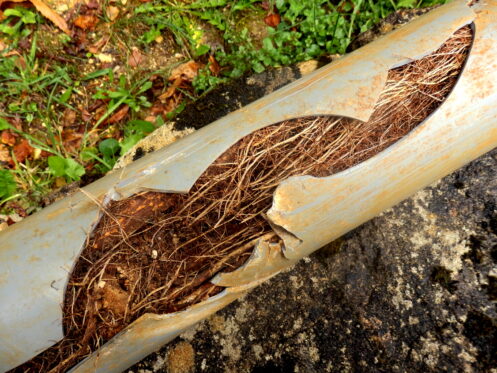Tree roots can profoundly impact your drainage system, often leading to significant problems that may go unnoticed until substantial damage has occurred. While essential to the tree’s survival, these silent invaders can gradually infiltrate drainage pipes, creating blockages, disrupting water flow, and ultimately causing system breakdowns. Drainage issues resulting from tree root intrusion can result in costly repairs and possibly necessitate full system replacement. Here, we will delve into six ways on how tree roots can affect your drainage system, helping you understand the signs of trouble, the potential consequences, and methods to prevent or remedy these issues.
1. Pipe Blockages
Tree roots are naturally drawn toward moisture, nutrients, and oxygen, all abundant in drainage pipes. As small roots infiltrate through tiny cracks or joints in the pipes, they can grow and expand, creating a net-like structure that traps solids flowing in the sewage. Over time, these solids accumulate, causing a blockage that impedes the normal flow of water.
In severe cases, these blockages can lead to sewage backflow into your home or flooding in your yard. This not only creates an unsanitary environment but could also potentially damage your property. In addition, clearing these blockages can be quite challenging as traditional cleaning methods may not fully remove the roots.
Furthermore, the root-induced blockages often lead to slow drains and gurgling noises from your toilets and sinks. Homeowners should never ignore these early warning signs of a drainage problem. If left unresolved, a simple blockage could escalate into a major drainage system failure, necessitating a costly and disruptive full system replacement.
Regular drain maintenance, including professional pipe inspections and drain cleaning, should be part of every homeowner’s routine to prevent root intrusion and subsequent blockages. In addition, property owners should consider strategically planting trees and shrubs around the property to avoid placement near underground pipes. Finally, root barrier installations can be an effective preventative solution for existing problematic trees.
2. Water Flow Disruption
Besides causing blockages, tree roots can significantly disrupt the normal water flow in your drainage system. As roots grow and thicken within the pipes, they restrict the space available for water to flow, resulting in slower drainage and increased pressure within the system. Over time, this increased pressure can weaken the pipe walls, leading to cracks, leaks, and, in severe cases, pipe bursts.
Water flow disruption might manifest in your home as a noticeable decrease in water pressure or unexplained damp spots in your yard. Periodically, you may also detect an offensive smell around the area of your pipes, a sign that leaks exist.
If a pipe bursts, the damage can be devastating and lead to serious property loss and soil erosion as it disperses through cracks in walls and surfaces. It also potentially pollutes surrounding water bodies if the broken or ruptured pipes belong to sewage systems.
To mitigate these problems, routine pipe inspections are essential, particularly for homes with large, mature trees. Early detection of root intrusion can prompt timely intervention, preventing minor issues from escalating into major problems. For trees known to cause issues, removal or regular root pruning may be necessary. Alternatively, homeowners can invest in root-resistant pipes or protective physical barriers to safeguard their drainage systems from root invasion.
3. Structural Damage
As tree roots grow and spread in search of water, they can exert considerable pressure on surrounding structures, including your drainage system. This is particularly true for older or damaged pipes more susceptible to root intrusion. As roots grow and expand, they can cause cracks in the pipe walls, weaken connections between pipes, and even shift the positioning of the pipes.
In addition, as roots absorb moisture from the soil, they can cause subsidence, shifting the ground and potentially damaging underground drainage pipes. This can lead to misaligned pipes, creating gaps and breakages that allow water to leak into the surrounding soil, causing further damage to your property.
Structural damage caused by tree roots is often difficult to detect until significant harm has occurred. Therefore, it is crucial to be vigilant for any telltale signs of structural damage, such as uneven floors, cracks in walls or foundations, and moisture spots around your property. Early detection can save homeowners from extensive repairs and costly replacements.
4. Sewage Backup
A severe consequence of tree root intrusion, often overlooked, is sewage backup. This unpleasant issue occurs when root-induced blockages or pipe damage prevents wastewater from flowing out of your property. Sewage backup presents a serious health hazard due to the potential spread of harmful pathogens in wastewater.
Furthermore, it can lead to significant property damage and necessitate an immediate response to mitigate further harm. Manifestations of sewage backup include wastewater from toilets, sinks, showers, or even floor drains, often accompanied by a foul odor. The best defense against sewage backup is preventative maintenance, such as frequent drain cleaning and periodic CCTV drain inspections that can reveal early signs of root intrusion.
In the event of a sewage backup, quick, professional intervention is essential to resolve the issue and clean the affected areas effectively. It’s also worth considering the installation of a backwater valve, a device that allows water to leave your property but prevents it from flowing back in. This can be a valuable addition to homes prone to root intrusion and subsequent sewage backup.
5. How Often Should You Inspect Your Drainage System?
Ideally, homeowners should schedule professional inspections of their drainage system at least once every two years. However, properties with mature trees or a history of root intrusion issues might necessitate more frequent checks, perhaps even annually. Regular inspections can uncover early signs of root intrusion, enabling swift action to prevent further damage.
During these inspections, plumbing professionals employ advanced technologies like CCTV drain cameras, which provide a clear, real-time view of the inside of your pipes. This technology allows for precisely identifying issues like root intrusion, pipe corrosion, or misalignments.
Therefore, an inspection schedule can help maintain the health of your drainage system, saving you from potentially hefty repair or replacement expenses down the line. For residents of Indianapolis, IN, Hope Plumbing can provide comprehensive plumbing inspection and repair services to keep your drainage system in top shape.
6. Additional Tips for Maintaining a Healthy Drainage System
Aside from regular inspections, there are a few other measures homeowners can take to maintain the health of their drainage system and prevent issues caused by tree roots. These include proper waste disposal practices, such as avoiding flushing nonbiodegradable materials down the drain, which can contribute to blockages and encourage root growth. Additionally, be mindful of where you plant trees on your property; keep them at least 10 feet away from underground pipes to reduce the risk of root intrusion.
Another useful preventative measure is to avoid overwatering your lawn. Excessive watering can cause tree roots to seek water sources, including your drainage system. This can lead to increased root growth and potential damage to pipes over time.
Lastly, consider seeking professional advice if you plan to plant new trees on your property. Experts can offer insights on the types of trees less likely to cause issues with underground pipes and suggest safer planting distances to avoid future complications.
Don’t let roots ruin your drainage. At Hope Plumbing, we offer high-quality drain cleaning, sewer repair, and plumbing services for residents of Indianapolis, IN. With our team of experienced professionals, we are prepared to meet any plumbing challenge from routine maintenance to emergency repairs. Don’t wait until your little problem becomes a big headache; contact us today.

